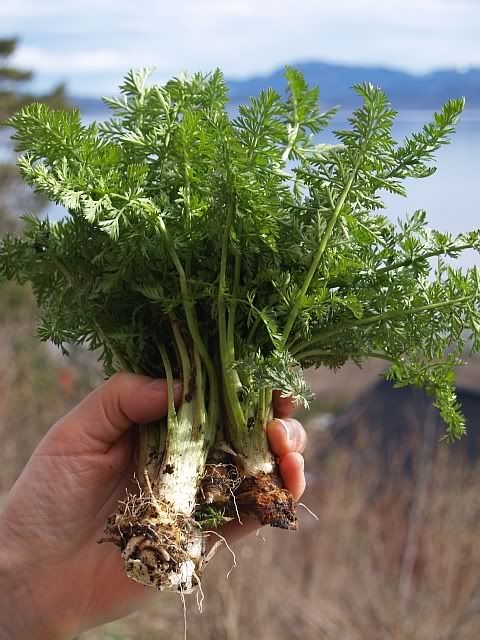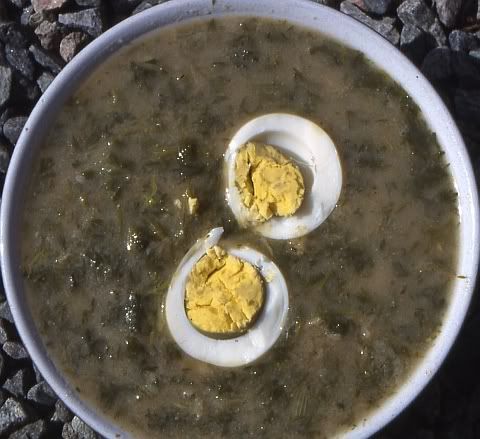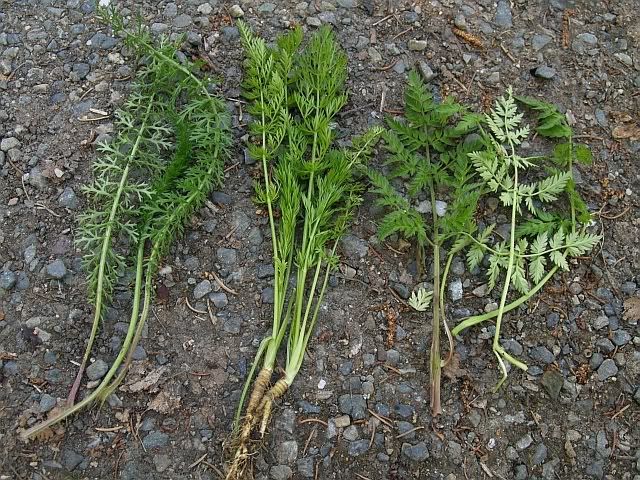|
|
Post by stevil on Mar 3, 2009 11:47:30 GMT -5
When I moved to Norway early in the 80s, I soon discovered the newly started local group of the Norwegian Useful Plants Society (Nyttevekstforeningen). That first spring, I joined the group’s annual spring foraging excursion. This was where I was first introduced to karve, a common herb in coastal meadows, and second in popularity only to nettle (Urtica dioica) as a wild green in Norway. Karve is none other than Caraway (Carum carvi), the well-known biannual herb which most of us associate with the aromatic fruits (seeds), used in various breads (particularly rye), sauerkraut (surkål in Norway), various European cheeses and various spirits, including the Norwegian national beverage, Aquavit. The difference between Caraway, Cow Parsley and Yarrow being demonstrated on a spring excursion of the local group of the Norwegian Useful Plants Society:  The young spring shoots of Caraway are ready for harvesting in early spring (late April/early May). They have a mild parsley-like taste not at all like the seeds.  They were traditionally used, particularly in the south east of the country, to make a soup (karvekaalsuppe). Karvekaal literally translates as “Caraway-Cabbage or -Greens”. This soup is described in Norway’s first cookery book by Hanna Winsnes in 1845. I was taught to harvest the plants with a sharp knife, cutting through the uppermost part of the root. This allowed the root to resprout and seed still to be set in the same year, so that harvesting doesn’t affect the local populations, a sound example of sustainable harvesting. However, it wasn’t just the leaves and seeds which were used. Norwegian botanist Fredrik Christian Schübeler who wrote a number of popular books on gardening in the mid-19th century, wrote in 1889 that in many places in the Austrian mountains, Caraway was being grown in places where it wasn’t possible to grow potatoes, and also for the roots. He tells the reader that Caraway roots are nutritious, easily digested and tasty. He also notes that the size of the roots can be improved by selection. Schübeler himself tells how he grew Caraway as a root vegetable in the Botanical Gardens in Oslo in the 1850s and that he managed to develop roots as big as the Hamburg Parsley (Petroselinum crispum). Today, as far as I am aware there are no cultivars of Caraway bred for the roots. Here there is potential for someone to do some selection work! Any volunteers? I agree with Schübeler that the roots have a pleasant, sweet taste. In fact, in Sturtevant’s Edible Plants of the World, a reference is given to an article from 1904 in which the author states that the roots are considered better than Parsnips!  |
|
|
|
Post by ottawagardener on Mar 3, 2009 11:55:26 GMT -5
Well I'm definitely interested in working to diversify hardy root crops, especially those that can overwinter in ground and cellar (have to check on Caraway's hardiness). The fact that they aren't too bothered by carrot rust fly makes them a big plus. I'll have to grow some this year to taste.
|
|
|
|
Post by stevil on Mar 3, 2009 12:03:50 GMT -5
|
|
|
|
Post by utopiate on Mar 3, 2009 12:12:43 GMT -5
I've wondered about this plant. I've heard that you can often sprout seed and grow it from the seed in your spice bottles. The Yampahs (Perideridia), which are very tasty wild roots, and once important staples to Native Americans, were in the genus Carum for a while before being classified in their own. It would be interesting if the two could inter-breed, but I suppose this isn't possible or they would probably still be in Carum.
The harvesting method seems a bit odd. I'd think leaving the crown would produce the most shoots, but other roots, like horseradish, do freely sprout from any sector of the major root. Must be responding somewhat like that.
|
|
|
|
Post by stevil on Mar 3, 2009 12:36:15 GMT -5
Yes, I'd forgotten the old classification of Yampahs - by the way, are they perennials?
I think the reason for cutting off the top of the root is that it is considered to be nutritious - I guess people discovered by trial and error how much of the root they could take without killing the plant. I haven't experimented with this, but usually take about 1-2 cm of the crown.
|
|
|
|
Post by stevil on Mar 3, 2009 12:41:25 GMT -5
I've wondered about this plant. I've heard that you can often sprout seed and grow it from the seed in your spice bottles. Perhaps some of the Homegrowners would like to try this and report back? I wonder a) if the seed needs stratifying (cold treatment) and b) whether the seed quickly loses its viability like Parsnip? I got some seed of an old Norwegian cultivated variety Polaris last year from the seed bank and it didn't germinate. |
|
|
|
Post by utopiate on Mar 3, 2009 12:46:55 GMT -5
They are perennials (the Yampahs or Perideridia), with the interesting habit of regenerating a new root (usually larger) out of the old root each season. A sort of offset root emerges from near the crown, grows down, enlarges, and the old root withers away as its energy is expended into the new plant growth and root formation. The old spent root is usually hanging off the side of the grown new root when harvested. I've noticed that the Yam Daisy (Microseris lanceolata) does this also, as do some of the Agoseris. Anyone know what this sort of annual root regeneration in functionally perennial plants is called? If I recall correctly, Scorzonera may do this too. Perhaps its not that much different than what we see happening in potatoes, but potatoes are stem tubers, whereas this seems to be a root origination for the regrowth. Well I guess these aren't tap-roots, they are swollen and storing energy in more of a tuberous nature.
Curious about the rooting of Carum carvi. Big taproot? Or tubers?
|
|
|
|
Post by orflo on Mar 3, 2009 14:28:51 GMT -5
Carum carvi is quite popular in Germany and, as Stephen already mentioned, in Austria, the German name for the seeds is kummel. I've had plants for about 8 years, they formed a small sort of carrot like root, the taste was good, even sweetish. They never self-seeded, and I eventually lost them about 2 or 3 years ago. I re-sowed them last year (but slugs ate them, so I have tostart all over again this year), no stratification is needed for the seeds (otherwise they would probably self-seed) , but they are short-lived, most umbellifer seeds are short-lived. I'll search a bit in Austrian seed catalogs, but, as far as I remember I never encountered a specific selection of the plants.
Some other plants were used in parts of Austria, and further to the east, phlomis tuberosa, stachys palustris,typha, and I'm forgetting some.
Anyone ever tried chaerophyllum aromaticum, described as having a 'kummel-like taste, as well in the leaves as in the seeds', and this one apparently needs some stratification (I'll obtain some seeds in October)
|
|
|
|
Post by stevil on Mar 3, 2009 15:08:01 GMT -5
I've had plants for about 8 years, they formed a small sort of carrot like root, the taste was good, even sweetish. They never self-seeded, and I eventually lost them about 2 or 3 years ago. Frank: Not sure I understand. Did your plants live for 8 years? Did you stop them flowering to stop them from dying? Anyone ever tried chaerophyllum aromaticum, described as having a 'kummel-like taste, as well in the leaves as in the seeds', and this one apparently needs some stratification (I'll obtain some seeds in October) My notes tell me that I sowed this late in 2004 and they germinated in May 2005. I know where the plant should be, but I can't remember if it was still there last year. I haven't tried it. Do you have a reference to this species being used for food? |
|
|
|
Post by utopiate on Mar 3, 2009 15:33:53 GMT -5
Note on Phlomis tuberosa: davesgarden.com/guides/pf/showimage/1183/Mine are slow growing and barely surviving my neglect, in no way resembling this prime specimen (seeds from JL Hudson). I did try eating some small tubers though, which were very astringent and not too good. The plants seem quite hardy though, and I am looking forward to the floral display and attraction for bees and hummingbirds. Might do a report on Stachys palustris at some point. I guess I will try to grow some of the Carum carvi now that iI hear it tastes so good. Were the roots of useable size in one season, or did it take several? I've seen seeds offerred in a catalog or two here if the store bought ones won't work. |
|
|
|
Post by mybighair on Mar 3, 2009 16:30:13 GMT -5
|
|
|
|
Post by utopiate on Mar 3, 2009 16:47:02 GMT -5
Thanks for getting that latin name right, on the Microseris lanceolata. I corrected my post. I have three forms which have been growing and blooming in indoor window pots all winter. They did not seem to self pollinate (I've been hand pollinating them), but now that I have done cross pollination I am getting seeds, and still waiting to determine if seed is setting between two different plants of the same variety I pollinated. I intend to do a post on this one sometime too, probably after the flowering stops and seed is ripe and I can dig out the tuber to photograph.
The one I tried before, was somewhat earthy and bland, a bit watery, and nothing to write home about, but certainly edible and rich in aboriginal history. It does grow a full size root in one season however, and wants to go dormant in hot weather. Withstands freezing and coolness very well. Winter growing in Australia I guess. Grazing has nearly wiped them out though, from what I have read. Not a lot of info online on them because they are hard to find, being endangered in much of their former ranges. That is one of the better links, some photos of blooming plants to be found also, but none of tubers that I have found.
|
|
|
|
Post by orflo on Mar 4, 2009 0:58:27 GMT -5
I've had plants for about 8 years, they formed a small sort of carrot like root, the taste was good, even sweetish. They never self-seeded, and I eventually lost them about 2 or 3 years ago. Frank: Not sure I understand. Did your plants live for 8 years? Did you stop them flowering to stop them from dying? Anyone ever tried chaerophyllum aromaticum, described as having a 'kummel-like taste, as well in the leaves as in the seeds', and this one apparently needs some stratification (I'll obtain some seeds in October) My notes tell me that I sowed this late in 2004 and they germinated in May 2005. I know where the plant should be, but I can't remember if it was still there last year. I haven't tried it. Do you have a reference to this species being used for food? You're right, it's quite incomprehensible, that's what's happens when you have a headache and still want to post something .... So, that's it, I did cut the flower stalks, not all plants survived it, but most did. The roots never became very thick however, but they were in my worst spot, so that didn't help. Perhaps a sunny place and better soil could double the size of the root, which was a very small varrot size... As for the chlaerophyllum aromaticum: no, I don't have a very solid reference (that's why I asked  ) , only read some personal comments on the taste and growing habits. Does anybody know more?? |
|
|
|
Post by flowerpower on Mar 4, 2009 5:51:07 GMT -5
Stephen, thanks so much for posting this. The pics are much appreciated. I traded someone for seed over the winter. Maybe I will wintersow some if it is a biennial. The leaves really do resemble yarrow. I like that Norwegian cheese called Nokkelost. It has the caraway seed in it. Very tasty  |
|
|
|
Post by stevil on Mar 4, 2009 11:50:03 GMT -5
Interesting that you should mention nokkelost. Apparently it is actually not caraway but cumin which is used (but tell me if I'm wrong - this is just what I have read on the net). This is a pity as nokkelost would be much more a Norwegian cheese using Caraway rather than sub-tropical cumin. The spice Caraway is often confused in Scandinavia with Cumin (Cuminum cyminum), which of course belongs to the same botanical family. However, Caraway has a very different, sweeter taste than Cumin. The confusion arises in that the Swedish name for Caraway is Kummin (Kümmel in Germany). By the way, here’s a picture of the young leaves of Caraway (middle) with its look-alikes (left) Yarrow (Achillea millefolium) and (right) Cow Parsley (Anthriscus sylvestris), difficult for novice foragers. Although rare in our area, young leaves could be confused with the leaves of the poisonous Fools Parsley (Aethusa cynapium) which is the reason we stress certain identification.  |
|










 ) , only read some personal comments on the taste and growing habits. Does anybody know more??
) , only read some personal comments on the taste and growing habits. Does anybody know more??

